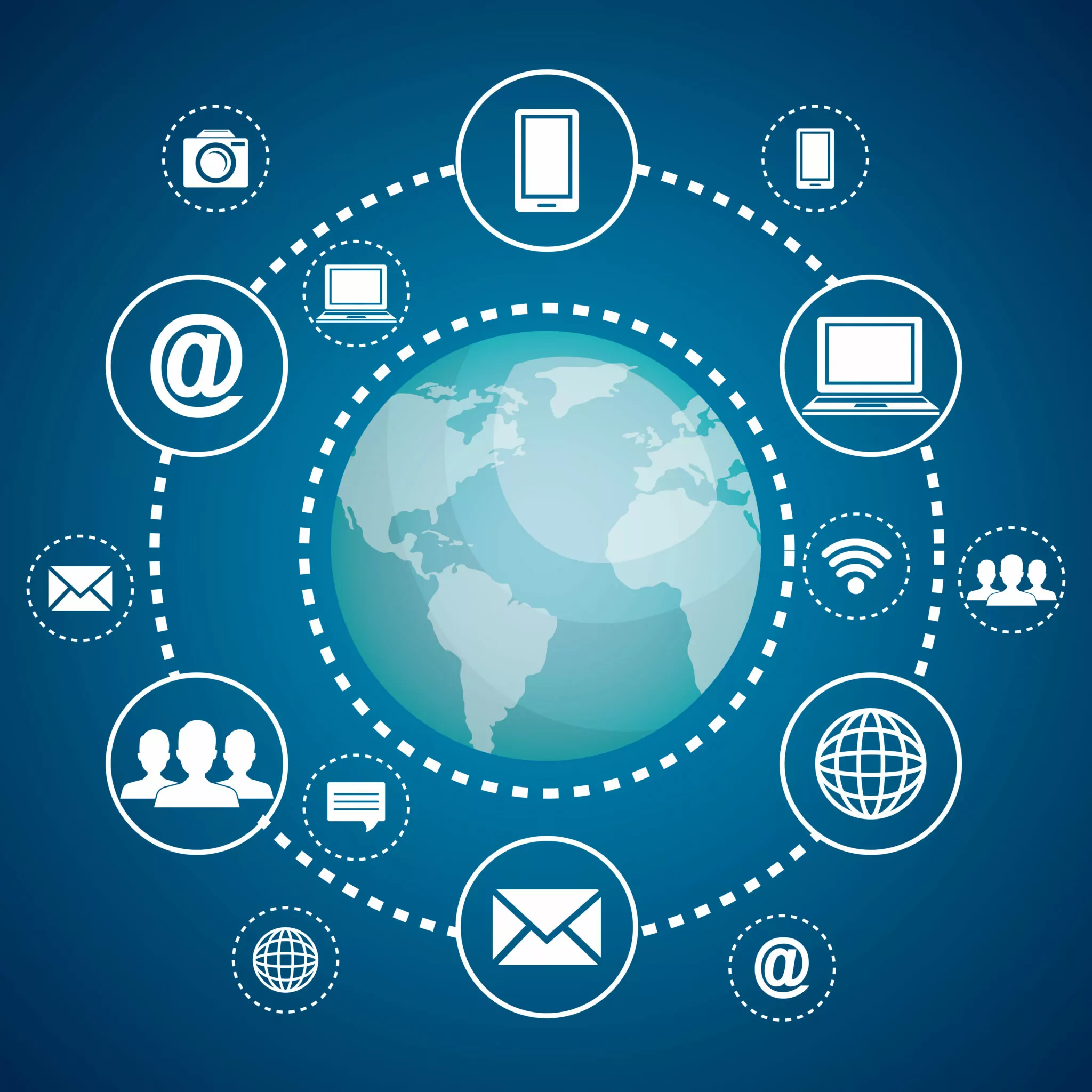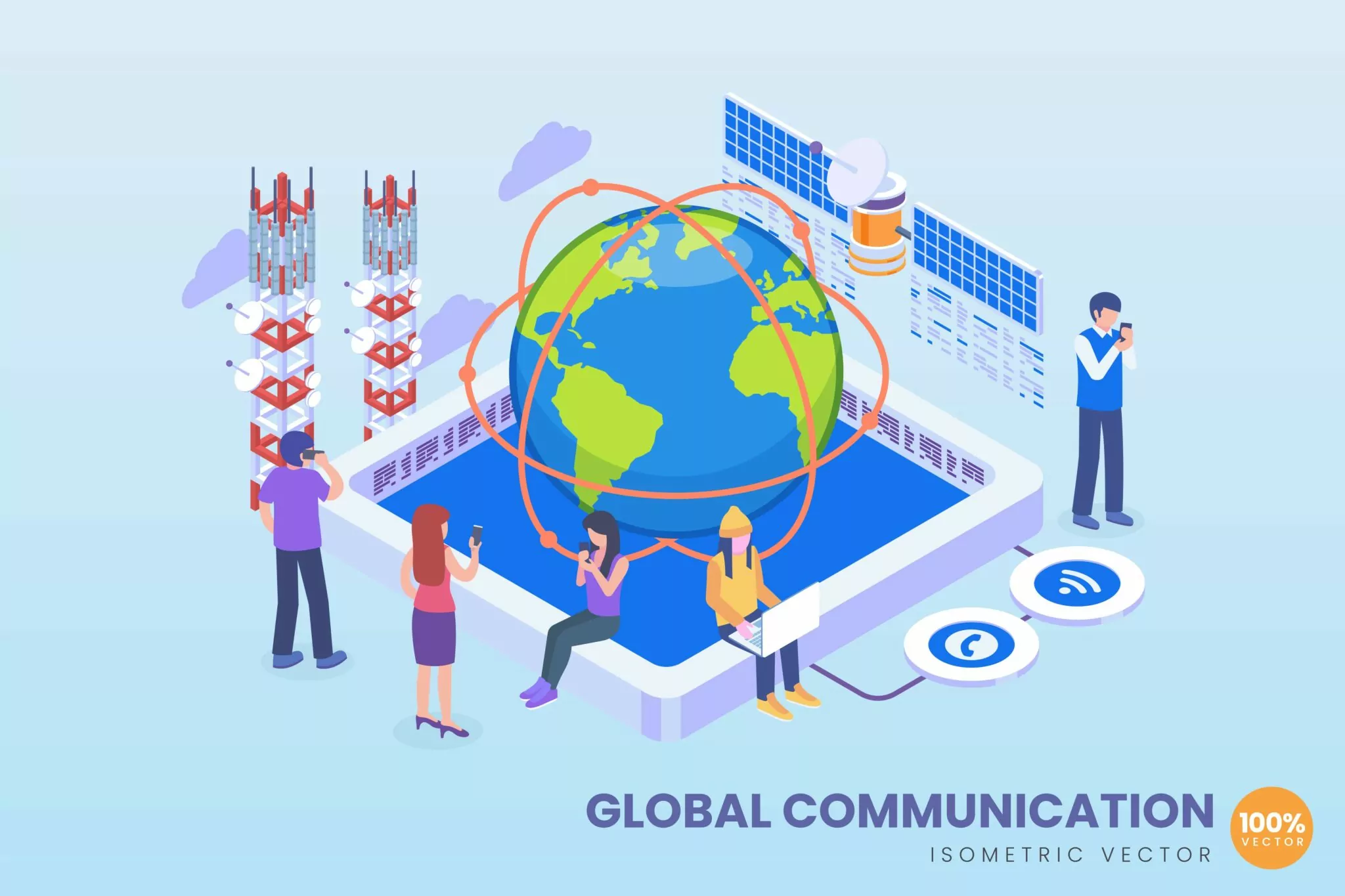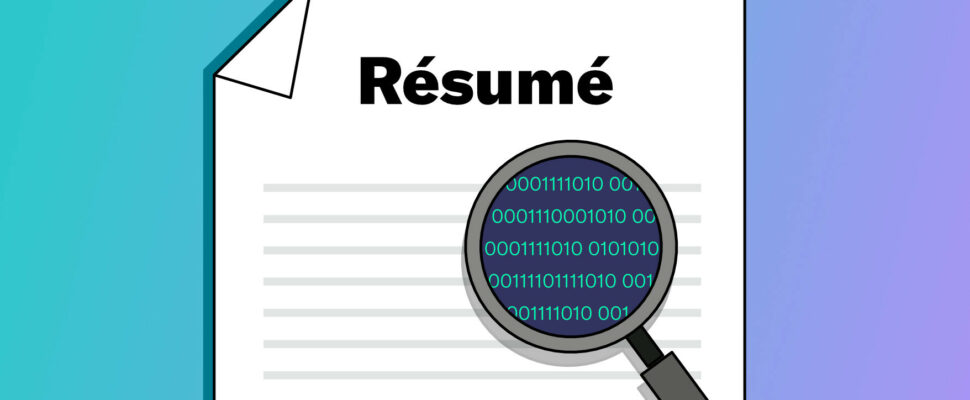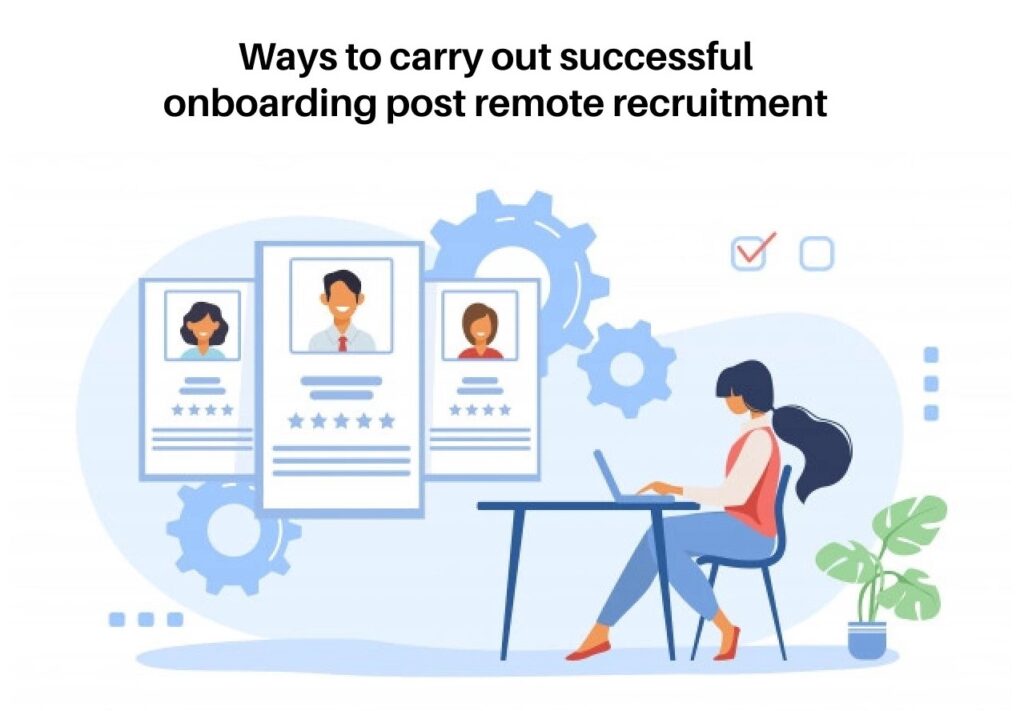
All posts by admin
The hardest part of starting up is starting out.

9 virtual interviewing guidelines for human resources professionals
One of the most effective ways for HR professionals to enhance candidate experience is to offer them a pleasant and comfortable interview experience. Virtual interviews that made a strong appearance during the pandemic are here to stay because of the multitude of benefits they offer to both candidates and recruiters. Besides, technological interventions have made the interviewing process seamless.
Virtual interviews are held online through interview platforms or video conferencing tools such as Zoom, Google Meet, etc. Virtual interviews offer candidates the option to attend an interview from any location of their convenience. The time of the interview is fixed based on the convenience of the interviewer and interviewee.

Types of virtual interviews:
Recorded interview: The interviewer can record the questions and provide these to the candidates. Candidates can record their answers and send them back.
Live interview: In this type of interview, the interviewer and interviewee are present and communicate with each other in real-time.
Video resumes: This is a format where candidates provide an overview of their education, experience, etc. in a video format. A video resume is not exactly an interview because the candidate is not answering questions in a typical interview format.
The basic requirements for a virtual interview are a microphone, camera, computer/smartphone, and access to interview software. Although interviews are conducted online, interview platforms offer a real life in-person interview experience.
Interview platforms offer a host of features to streamline virtual interviews. Some of them are:
Support different question formats: Some video platforms allow interviewers to provide pre-established questions. These questions can be provided in the text, audio, or video formats.
Interview scheduling: Many video interview platforms have an integrated appointment scheduling feature. This feature not only schedules interviews but can also reschedule them if required. The software also intimates the concerned parties about any changes.
Applicant assessment: Interviewing platforms facilitate applicant assessment by scanning applications from job seekers and shortlisting candidates.
Support panel interviewing: Some interview platforms support panel interviews wherein multiple interviewers or interviewees can attend the interview at the same time.
Sending reminders: Video software includes the feature to send notifications to candidates reminding them to furnish any details/documents required. It also sends reminder alerts to candidates to attend the interview.
Seeking feedback: Some video interviewing platforms include an automated feedback form through which recruiters can ask for feedback from the candidate. The feedback form can also be customised for each candidate.
Recording: Virtual interview platforms also include the feature to record and play back video clips of the interview. Some platforms store the recorded interview in cloud storage. Access to recorded interviews makes it easy for recruiters to discuss the hiring process with other colleagues.
Besides these, there are several other features that virtual interview platforms offer. Hence, hiring professionals have the option to choose a platform that includes features relevant to their needs.
At first look, virtual interviewing might seem to be a simple and straightforward process. However, it is a good idea to plan the interview in detail to ensure that the process is seamless for both the interviewer and the interviewee.
9 tips for virtual interviewing
- Choose and test the platform
There are different types of virtual interview platforms available in the market. Compare the features of different platforms and choose the one that best meets your needs. Also, you will need to familiarise yourself with the software before you use it. Ideally, test the software before using it.
- Structure your interview
Structuring the interview entails establishing factors such as whether the interview will be conducted by a panel or an individual, who will be in the panel, the approximate duration of the interview, the sequence in which questions will be asked, and more. Simply put, the recruiters will need to prepare a roadmap for the interview.
Once the structure is prepared, everyone who is a part of the process will need to be informed about their roles and responsibilities in the process.
- Prepare the interview questions in advance
Based on what you want to assess through the interview process, prepare a list of questions that will provide you with the answers you are looking for. Having a list of questions in advance ensures that you do not waste time and the process is completed fast. Besides, preparing the questions well in advance ensures that you do not miss out on any vital point while conducting the interview. Moreover, having a pre-determined list of questions ensures that the interview progresses in the right direction without too many digressions.
- Send invitations to candidates
Once you have done all the preparations from your side, you can send invitations to candidates based on a mutually convenient date and time.
- Provide clear directions to candidates
Inform the candidate well in advance about the interview software that will be used so that they have the time to download it and familiarise themselves with the tool. Also, you can resolve any queries that the candidate may have regarding the process. You can inform the candidate if anything specific is required from their side.
- Give a clear idea about the job role and company culture to the candidate
An interview is a time when the interviewee and interviewer come face-to-face for the first time. It is an opportunity for the interviewer to introduce the company and job to the candidate. The interviewer can explain what the job role entails and what is expected from the candidate. Importantly, the interviewer should describe the company culture to candidates so that they have an idea of what to expect upon joining. These details will also help candidates assess if they are genuinely interested in working for the organisation or not.
- Maintain consistent communication with the candidate
One aspect of interviews that candidates dislike is long waits with no updates from the recruiter. Inconsistent communication offers a bad candidate experience. Hence, recruiters must ensure that they maintain clear and consistent communication with the candidate via text messages/emails. A transparent process helps candidates understand how they are progressing. It is a good practice to inform candidates even if they have been rejected.
- Invite feedback from the candidate
Feedback from candidates helps recruiters understand the positive and negative aspects of the hiring process. This will help you develop better interviewing processes for the future to enhance the candidate experience. If you are using virtual interview software, the process becomes easy because the platform generates a customised feedback form for different candidates.
- Explain the next steps to the candidate
Inform the candidates who have been selected and explain what is to follow. This will include details such as any documents required from their side, the onboarding process, etc.
If you are uncertain whether to opt for virtual interviewing or in-person interviewing for your company, do weigh the pros and cons of both before choosing the option that seems right for you.
Advantages and disadvantages of virtual interviews

Virtual job fair abstract concept vector illustration. Virtual recruitment agency, online hiring event, digital hr, job proposal, vacancy fair website, build professional career abstract metaphor.
Advantages of virtual interviews
Minimises costs: Virtual interviews save costs for recruiters because they do not need to invest in a venue for the interview. The candidate does not have to spend on commuting, lodging, etc.
Offers a large resource pool: Virtual interviews enable recruiters to interview candidates from any location across the globe.
Convenience: Remote interviews are convenient for both the interviewer and interviewee because the interview can be conducted from any location of their preference.
Easy to schedule: Interviewing platforms automate the scheduling process. The software makes it easy to schedule or reschedule interviews.
Saves time: Virtual interviews proceed faster than in-person interviews. They cut down on the travel time for the candidate. Besides, virtual interviewing platforms offer recruiters the facility to go back and watch the interview again to get a better understanding of the candidate. Recorded interviews also enable interviewers to watch the video with other colleagues if required.
Minimises stress for candidates: In a formal interview setup, many candidates tend to get nervous. This impacts their performance and in some instances, candidates may even back out from the interview. Many candidates are not comfortable in an in-person interview and may not give their best performance. However, in a virtual interview, since candidates appear from a location of their convenience, they tend to be more at ease and perform better.
Disadvantages of virtual interviews
Technology issues: The success of a virtual interview depends on the seamless functioning of technology. Often virtual interviews may suffer from snags such as poor video quality, network issues, and more.
Limitations due to candidates’ lack of IT expertise: Virtual interviews require the candidate to have an understanding of and access to technology. A lack of expertise in working with video conferencing tools might prove to be a deterrent for many capable candidates.
Distractions: An interviewer/interviewee could get distracted by unforeseen disturbances in their immediate environment. Besides, factors such as noise and improper lighting may impact outcomes.
Missing non-verbal cues: During an interview process, interviewers can assess the candidate through non-verbal cues like body language, style of communication, dressing style, etc. In a virtual interview, the interviewer gets a brief glimpse of the candidate and hence, may find it difficult to assess many non-verbal aspects.
Conclusion
Notwithstanding these minor disadvantages, virtual interviewing is expected to be the preferred mode of conducting interviews in the future. If you are looking to recruit the best talent ahead of your competitors, invest in a reliable virtual interviewing platform to leverage its many benefits. HirePro is among the leading virtual interviewing platforms that offer a streamlined interviewing process. The software includes a plethora of features that enhance the candidate experience.

Going phygital with campus hiring
Campus recruitment has always been challenging for recruiters, given the logistics, high-volume hiring and complexity of workflows involved. When the pandemic forced this huge exercise to go remote, recruiters began appreciating the power of digital technology to speed up hiring processes and reduce costs. Now, with pandemic restrictions gone, recruiters everywhere are embracing “phygital”, combining the best of both worlds, physical and digital. For campus recruiters in particular, phygital campus engagement offers immense advantages. Let us see how it works.
| As companies adopt the hybrid mode of working, they’re moving towards a new normal – phygital hiring – the combination of digital and physical hiring. (HirePro’s market study on remote recruitment, Feb 2023)
“The hybrid model of recruitment is the future. On our campus only 4% of recruitments were done offline. Only small and local companies prefer the offline mode.” Rashmi Bhandari, Dean of Placement, Sahyadri College of Engg. & Management in The Times of India |
Phygital campus engagement: benefits and drawbacks
On the digital front, AI-powered platforms offer a host of gains for large-scale campus hiring:
- Time saved on logistics and travel
- Cost on junior-level recruitment reduced
- Access to diverse and high-quality talent across geographies widened
- Bias during selection eliminated
- Screening time reduced
- Organisation positioned as innovative and future-ready, giving it a competitive advantage
There is a downside too. A recent HirePro market study highlighted employers’ concerns about candidates engaging in malpractices during online testing and interviews. At the candidates’ end, poor digital infrastructure can be frustrating.
Nevertheless, with the pluses outnumbering the minuses, phygital hiring will continue to gain traction.
Phygital/hybrid hiring processes

Going phygital involves tweaking campus hiring methods. Here are three possible approaches:
- Blended: Recruiters adopt a mix of online and offline hiring processes, for example, video-call interviews for initial screening, followed by in-person meetings with shortlisted candidates in the final phase.
- Composite: Here, employers parallelly organise hybrid events. A company may opt to conduct virtual career fairs for Grade 2 and 3 colleges to save on time and cost while simultaneously organising on-campus interviews for Grade 1 institutions.
Including a virtual component offers another advantage—recruitment teams can approach colleges that were previously ignored because of prohibitive travel costs. - Synchronous: Here, physical and virtual components are combined for the same event. For example, not all candidates may be able to attend an on-campus hiring event. Giving such students the option to connect virtually to the campus recruitment team widens recruiters’ access to candidates.
In practice, wise employers pick the phygital process that suits them best or consider a mix-and-match strategy.
Best practices for phygital campus engagement
Transitioning from physical to phygital is not a cakewalk! Here are some ideas that can help:
Transition smoothly from offline to phygital
- Communicate the transition process clearly to your campus coordinator in terms of dates and the events to be conducted in-person or virtually.
- Select a reputable online platform to seamlessly manage your entire workflow, including assessments with proctoring to prevent malpractice during initial screening.
Choose the right recruitment software
For the digital part of your strategy, select an appropriate campus hiring workflow software to test candidates in a virtual environment. Automated processes also ease your tasks. For example:
- Assessment software helps you develop and send a test to students to facilitate screening.
- Automated email messages help to maintain consistent communication with job applicants. You can, for instance, create messaging content appropriate for each stage of recruitment to improve candidate engagement.
Promote your phygital campus event on social media
Millennials and Gen-Z candidates spend vast amounts of time on social media platforms. Hence, a social media strategy, besides conventional on-campus promotions, is a must. Some ways to reach your target audience:
- Share posts on employment-related platforms like LinkedIn and WhatsApp groups frequented by university students.
- Create informal videos featuring your employees. Discuss the positives of working for your organisation. Share these on Instagram, YouTube, LinkedIn or university Facebook pages.
- Your present workforce is your best ambassador. Ask your employers to share information about the phygital event on their preferred social media.
Build your employer brand
To attract high-quality talent during campus hiring events, companies must strengthen their employer brand. It is no secret that millennial and Gen Z job seekers extensively research potential employers before making a choice. Your organisation’s commitments to diversity and inclusion, larger social issues, employees’ mental health and career development, etc. all count towards determining whether you are a suitable employer. To amplify your employer brand, you could:
- Organise on-campus programmes such as workshops, seminars or a virtual discussion on LinkedIn on topics close to Gen Z to showcase the company’s values and ethos.
- Share comments from your employees on social media about their working experiences and perceptions of your office culture.
References:
- https://www.forbes.com/sites/blakemorgan/2022/05/16/the-rise-of-the-phygital-experience/?sh=3474fe945b97
- https://timesofindia.indiatimes.com/city/mangaluru/college-campuses-continue-with-hybrid-recruitment/articleshow/90279383.cms
- https://www.brazen.com/resources/hybrid-recruiting
- https://www.nibusinessinfo.co.uk/content/advantages-and-disadvantages-virtual-recruitment
- https://www.hrkatha.com/research/how-do-employers-rate-the-benefits-of-remote-hiring/

How technology mitigates the challenges in remote recruitment
Remote and hybrid work models are here to stay, so how can remote recruitment be far behind? It offers recruiters and candidates flexibility in terms of time and location, is less expensive and has a very wide reach. On the other hand, malpractices during assessments and the lack of face-to-face interaction between candidates and recruiters can hamper the recruitment process. Technology, however, has ways to overcome such hurdles.
HirePro carried out a market study to understand the advantages, factors behind its adoption, challenges and way forward for remote recruitment. Opinions from about 300 HR managers and talent acquisition leaders across different industry sectors were obtained and analysed.
How widespread is remote recruitment?
The study reveals that before 2020, only about 10 per cent of recruitment was fully remote. The numbers reversed when the pandemic struck and 80–90 per cent of organisations moved completely to remote recruitment. In the new ‘normal’, 85–90 per cent of recruitment continues to be partial to fully remote. In campus hiring, a little over 70 per cent of organisations are still using remote recruitment methods.
How technology drives remote recruitment
- Cost and time savings: As per the HirePro study, remote recruitment saves both time and cost across all levels of hiring, from campus to senior level. Physical recruitment involves travel, boarding, space and equipment, printing and other miscellaneous costs. Each step is time-consuming too, especially in cases of high volume recruitment such as campus hiring.
- Access to global talent pool: Remote recruitment automatically enables access to the global talent pool, which is not bound by geography. It works well for both recruiters and candidates.
- Better screening: Screening candidates at the beginning of a recruitment drive is very time consuming, especially when it involves large numbers such as in campus and junior-level hiring. Remote recruitment uses filtering tools that help search engines pull up appropriate candidate resumes. The more sophisticated the search tools, the more refined the results. Automation can further help with screening. The HirePro study found that efficient screening was a significant advantage in the mid-level hiring process.
- Efficient selection processes: Using an artificial intelligence (AI)-driven selection procedure after the initial screening can make testing and interviewing more systematic and thorough. Online assessments help reduce time and the chances of human error affecting a selection.
Assessment tests for different openings can be customised, making each test relevant and on point. HirePro’s Automated Coding Assessments offer all of these and more. Fitted with over 2000 questions, the tests can be customised first for filtering and later for assessments. The platform provides qualitative insights about every candidate that takes the tests. It is also built with automated detection and control of cheating.

- Efficient interview management: Remote recruitment processes can not only assess candidates through written tests, but also through live coding interviews and asynchronous and live video interviews too. Video interviews allow recruiters to observe candidates while providing candidates the opportunity to interact with representatives of the organisation, perhaps for the first time.
Outsourcing interviews is gaining popularity too. Small organisations sometimes do not have the necessary resources to conduct the interview round. They have the option of outsourcing the interviews to an interview panel. Large organisations may also outsource the interview round when hiring for the junior levels of the organisation. Hirepro’s interview platform offers numerous benefits including AI-powered proctoring.
- Conduct proctored tests and interviews: Impersonation is a real problem during remote recruitment processes. Cheating, fraudulent behaviour, plagiarism during written tests and the presence of other people with a candidate during virtual interviews are other prominent hiccups of remote recruitment. However, there are solutions to tackle these issues. Proctoring software is one such solution.
HirePro’s AI-powered proctoring platform can handle almost all these problems. Automated warnings, live proctoring, auto-expiration, question randomisation and many other attributes enable organisations to carry out safe and fraud-free selection processes.
- Engage candidates and offer support: Remote recruitment makes it a little difficult for candidates and recruiters to build a connection that keeps both sides engaged. Organisations can stay connected with the top candidates through emails, social media, virtual helpdesk and other communication platforms. Candidates can be updated about organisation news and other project-related information at regular intervals. Complete disengagement between the selection stage and the onboarding stage can make top candidates lose interest or accept offers from competing organisations.
- Make pre-onboarding and onboarding a welcome experience: The recruitment process is complete only after a candidate joins the organisation. Until then, it is important to keep the candidate engaged and feeling welcome. Chat and other communication channels should be kept open so that information can flow freely.
Enabling candidates to submit their documents online before joining is a big plus. It eliminates the pain of filling out numerous forms on the first day. The documents can be verified by using AI-driven tools to save time and increase efficiency.
HirePro’s AI-powered onboarding platform can help organisations handle all these processes. Other than enabling smooth communication between the organisation and the candidates, the tool’s advanced analytics and reporting features enable organisations to make informed decisions about the offers they make.
Given all the advantages, it is no surprise that the HirePro study reveals that remote recruitment is not going away soon. Organisations may prefer to use both remote and physical recruitment processes. In fact, a new term has been coined to explain this: phygital hiring. Recent times have shown that the challenges of recruiting remotely can be managed by using appropriate tech tools and strategies. During the pandemic, the first challenge of remote recruitment was probably the lack of sufficient experience. Now, people are aware and prepared. Technology can sort out this exercise too.
Sources:
- https://hirepro.in/resources/reports/e-recruitment-the-new-normal-of-recruitment
- https://pluo.jobs/blog/the-challenges-of-remote-recruitment/
- https://www.peoplematters.in/article/recruitment/can-technology-mitigate-the-challenges-in-recruitment-18291
- https://www.turing.com/blog/challenges-to-remote-hiring-and-how-to-overcome-them/

The anywhere office: How remote work is shaping the workforce
Introduction
Doing the laundry has supplanted the hustle and bustle of getting ready for work. A stroll to the living room makes up for post-lunch wanderings. Work breaks involve stirring a curry or putting away dishes. Water cooler and coffee vending machine conversations might be from another era.
Welcome to remote working, the transformational force behind the way we work. With more and more businesses recognising the benefits of work-from-anywhere, it is becoming increasingly clear that this trend is here to stay.

But remote working isn’t just changing the way we work— it’s also having a profound impact on the modern workforce in a variety of ways. Here’s how:
Freelancers are now commonplace
In modern times, work-life balance has become a priority for many employees, leading to a demand for flexible work arrangements. To retain talented workers, employers have responded by offering more wiggle room for their staff.
However, it’s not just changing priorities that have given rise to the gig economy; shifting market trends and economic policies have also played a significant role in the rise of on-demand jobs. Besides, gig work has been greatly facilitated by high-speed internet.
Employers boast of a skilled workforce
Nowadays, location is less relevant in the hiring process. This implies that you are up against candidates from all over the world with strong academic credentials.
Furthermore, technology advances quickly, creating new jobs and rendering some employment obsolete. Institutions cannot produce graduates with the necessary knowledge at the same pace.
Therefore, hiring decisions factor in skills like attitude, communication and learning ability; they no longer consider just a prestigious degree. Today’s workplaces offer glimpses of a future focussed on skills, not degrees.
Diversity is unmissable
Staff with physical disabilities, cognitive impairments, varied cultural backgrounds and different sexual orientations are becoming more common.
Among the factors contributing to today’s diverse workforce are globalisation, talent from all over the world, inclusion and diversity movements, and technological advancements.
Companies have begun to realise that a diverse workforce brings unique perspectives to the table, serves customers better and even helps fill labour gaps faster.
Teams are more productive
Remote work frees up commute time for more productive pursuits or personal activities. It also offers more flexibility over schedules, allowing workers to optimise work-life balance.
Studies have shown that remote working has increased employee satisfaction and happiness, motivating them to perform better.
Overall, remote working is proving to be more productive by reducing commute time, increasing flexibility and improving job satisfaction.
Conclusion
Remote work is transforming the modern workforce in numerous ways. As more companies embrace remote working, it’s likely that we will continue to see the impact of this trend on the way we work and live.
While there certainly are challenges associated with remote working, such as communication and collaboration, it’s clear that the benefits far outweigh the drawbacks.
With the right strategies and tools in place, remote working can be a highly effective way to create a more productive, engaged and innovative workforce.
Ref:

Communication technology will shape the future of remote work
Remote work, working from home or telecommuting has come of age in the post-pandemic era. Remote work arrangements may be temporary, permanent, part-time, full-time, occasional or frequent. An organisation will need to have policies regarding device usage, network security and expected performance to seamlessly adopt remote work.
Until about a decade ago, remote working was not widely acceptable. Employers thought that the workers would be easily distracted when working from home, without the supervision of the managers. The Covid-19 pandemic brought the curtains down on all such perceptions. It caused major disruptions in various aspects of life. Apart from our personal lives, the professional work culture saw a massive turnaround. After seeing financial losses due to forced shutdowns, companies had no option but to switch to remote working. As it turned out, the benefits of remote working made it popular and now, in the post-pandemic times, work from home continues to dominate trends.
The changing work culture
The pandemic had a phenomenal impact on the work culture. With lockdowns and travel restrictions dictating life, several organisations shifted their work to remote locations. Work culture in the post-pandemic era is bound to be different. Earlier, 9 to 5 was the slogan of the corporate world. Now, many businesses have given up their rigid work structure and timings in favour of remote working.

Employees prefer remote working because it enables them to maintain a great work-life balance and eliminates the cost of a daily commute. It offers them an opportunity to work at their pace and from the comfort of their homes without unnecessary interruptions.
Employers have also reaped the benefits of remote working. They have been able to cut the cost of maintaining extensive office infrastructure and making payments towards commute while, at the same time, enjoying the involvement and productivity of happier employees.
Essentially, it is a win-win situation for both organisations and employees! The efficiency of employees has undoubtedly improved. And, efficient employees means better business outcomes.
The prime mover for the culture of remote working is technology. In the past couple of years, we have witnessed how the demand for technologies such as the cloud and video conferencing tools has surged. The efficacy of a remote or hybrid work environment depends largely on the technologies used to support it. Several automation technologies are being harnessed to streamline various workflows. But, in a remote working environment, the emphasis is on seamless communication. Numerous innovative communication technologies have come to the forefront to facilitate working from anywhere in the world.
Communication technologies in the remote working environment

- Video conferencing
It is a very powerful tool for remote working. If you host a meeting with remote workers, a video is obviously a must. The best substitute for face-to-face meetings, video conferencing has become one of the “most useful technologies” for employees inside and outside the company. With a smart video conferencing camera, remote workers feel as if they are in a conference room, present with their colleagues in the office.
People can talk to each other in real-time from anywhere. Upgrade the workspace with a quality video conferencing solution to provide team members with seamless virtual communication. It positively impacts teamwork, cohesion and productivity. Many businesses waive the internet bills of employees so that everyone can afford a speedy connection. This is a good practice that other businesses can emulate to enhance the productivity of remote work.
Some popularly used video conferencing tools are Zoom, Microsoft Teams, Skype, etc.
- Collaboration using the Cloud computing technology
Cloud computing enhances security and allows users to access remote virtual work environments.
The benefits of cloud computing:
- It is cost-efficient.
- It eliminates the need to spend money on equipment and infrastructure or free up IT staff.
- It allows adding/removing services as required.
- It is comfortable and scalable.
- Remote workers have easy access to data. The cloud makes it easy to collaborate and share files. This enables multiple users to work on the same file simultaneously.
- A user can log in once, from anywhere and any device, for a seamless and secure experience.
- Project management tools
If your employees are spread out in different locations, project management tools allow them to communicate synchronously and collaborate to get work done. There are general project management tools and tools specific to different business areas. No matter what type of remote team you are in, a project management tool is a mandatory investment. Several project management tools like Microsoft Project, Trello, Evernote, and more are being adopted by businesses across the globe for better outcomes.
- Messaging
Written communication is the most common way to communicate remotely with clients and colleagues. It is much easier to send someone an email and let them spend their day than to call someone, leave a voicemail and then play the phone tag for a few days.
However, email is the most effective way to communicate with your team only sometimes. Whether it is a one-on-one chat or having multiple users on the same email chain, messages can still be missed or misunderstood. This is where messaging apps come in. Messaging apps allow you to communicate with one person or more in an open environment. You can also use rules to set up “channels” to keep people on the topic and eliminate confusion and tangents. Messaging apps like Slack, Telegram, etc., are being widely adopted by businesses for seamless collaboration.
- Storage tools
To make remote working effective, companies need virtual storage space. Everyone can upload their work to this virtual station for future reference or to be checked by the managers. Some popular and easy-to-use document storage solutions are Google, Dropbox and Microsoft Onedrive for Business.
- Mobile tools
Remote employees usually work with mobile devices and laptops. Including mobile in the workflow offers new possibilities for remote employees. Mobile tools also enhance productivity because they enable remote workers to work on the move.
Here are some examples of mobile tools that can be used:
Mobile apps like AnyDesk facilitate access and control of desktops, servers, etc.
Employers can provide remote VPN access to employees.
The availability of Wi-fi devices ensures that employees have a stable internet connection at all times.
- Unified platforms
Platforms like Google Suite and Slack have made collaboration seamless. These tools facilitate seamless collaboration in real-time. They make live idea-sharing easier and improve outcomes. They reduce lags and errors in the communication process.
Future of remote working
Remember the email that said, “We will shift to work-from-home policies until further notice” that appeared in your inbox back in 2020? Even after vaccinations, businesses did not switch completely to in-office locations again. Some organisations continued with remote working while some others opted for a hybrid work model.
In 2020, millennials were the largest working force, and they looked at work differently from the past generations. Many surveys suggest that millennials are comfortable working from home. Statistics show that people working remotely are 47 per cent more productive. Do not be surprised if this generation does not consider jobs that do not offer remote or hybrid working options. This is because of the comfort that working from home offers, besides the advantages of flexible working hours and a good work-life balance.
As long as millennials are the largest working group, remote working is likely to continue. In 2023 and beyond, companies must prepare to adapt to remote work. Technological advancements are keeping pace with the disruptions in the work culture.
As work shifts online, HR must keep pace. “The HR software market could reach $33.04 billion by the end of 2024.” (Source: https://ddi-dev.com/blog/it-news/hrms-vs-hris-vs-hcm-what-is-the-difference-between-hr-software/). This new kind of technology in business communications makes it easier for HR managers to get their teams to collaborate online. HR departments can now use digital communication tools to connect employees and improve productivity.
Communication technology trends

Some of the emerging technologies that will shape remote work include:
5G: Wireless speeds will be much greater with 5G than with 4G, which is currently being used. 5G will not only enhance the speed and reliability of remote work but also make it seamless. It will foster the integration of technologies like Augmented Reality (AR) and Virtual Reality (VR).
AI-based software: Artificial Intelligence (AI) and Machine Learning (ML) technologies will enable employees to view each other’s work, retrieve data and work seamlessly. They will also enhance privacy and facilitate anonymous working. AI bots will improve cybersecurity and reduce the risk of cyberattacks.
Virtual Reality (VR): VR offers an immersive experience wherein an employee can select their preferred work environment. It also facilitates virtual realistic and engaging interactions with other employees. This technology has the potential to offer more interactive features in the future.
Technologies will work in tandem to facilitate working from anywhere at any time without any wait time. They will enhance the employee experience and provide a secure environment. While employees will find it easier to connect with each other, they need not fear that data privacy will be compromised. It will most certainly be maintained. All these factors will directly improve productivity and enhance outcomes.
Conclusion
We are slowly moving into an era where hybrid working culture will be the new normal. It will increase opportunities for employees while providing access to a larger talent pool of employers. However, the key to productive outcomes through remote working is largely dependent on the efficiency of communication. Seamless communication between different entities paves the way for effective collaboration, leading to faster and better decision-making. Video conferencing and project management tools have definitely simplified the process. The future of remote working looks promising on the horizon with technologies like 5G and AI, which will boost the efficacy of remote working.
Resources:
- https://resources.owllabs.com/blog/remote-working-technology
- https://timesofindia.indiatimes.com/blogs/voices/whats-the-future-of-remote-work-in-2023/
- https://www.forbes.com/sites/theyec/2023/01/10/whats-the-future-of-remote-work-in-2023/?sh=10889db65864
- https://ddi-dev.com/blog/it-news/hrms-vs-hris-vs-hcm-what-is-the-difference-between-hr-software/

Remote recruitment: The benefits, challenges faced, and hiring strategy
In pre-pandemic times, recruitment mostly happened in the in-person mode. Hiring managers and talent acquisition (TA) teams preferred to meet prospects physically even though remote recruitment options were available. Most stakeholders felt uncomfortable adopting tech-enabled solutions to make hiring decisions.This outlook underwent a drastic change when the pandemic set in. There was no option but to adopt technology to ensure business continuity through remote hiring.
Remote recruitment tools and platforms were already quite advanced when the pandemic hit; widespread adoption helped to understand the challenges and streamline processes. As per the findings from a market study by HirePro, titled e-Recruitment — The New Normal of Recruitment, Physical to Phygital, which was conducted to understand recruitment modes before, during and after the Covid-19 pandemic, during the two years of the pandemic, the tables turned to such an extent that almost 90 per cent of organisations opted for remote recruitment.
When TA stakeholders experienced the benefits of remote recruitment in real time, mindsets changed and acceptance grew. As a result, recruitment did not revert to its pre-pandemic fully physical mode in the post-pandemic normalcy. 85 to 90 per cent of organisations continued remote recruitment in some form for hiring across all levels. Physical recruitment existed only in campus recruitment, that too only in about one-fourth of the total number of organisations hiring. Recruitment has now evolved into a hybrid mode; it is mostly remote. Physical recruitment comes into play when there is a need. No stakeholder foresees a return to the previous cent per cent physical mode.

This scenario has resulted from the changed priorities of organisations and job seekers. Organisations understood the need to build resilience in their hiring processes and the multiple benefits of remote recruitment. There was an increased preference for remote work among the workforce in post-pandemic scenario. Some other trends, like the rise of the gig economy, the need to create a more diverse, inclusive global workforce, etc., added to the evolution of the TA industry.
This blog brings out relevant data points from the study report, highlighting the benefits, challenges and future of remote recruitment. Let’s first look at the various benefits that remote recruitment offers.
Benefits
- Cost and time savings: Remote recruitment eliminates the need for travel for both candidates and recruiters. Even though a few organisations preferred the in-person mode for the final interview and onboarding of new hires, many opted for fully remote recruitment. What prompted this change?
Organisations are citing time and cost savings across all levels as the topmost benefit. The remote recruitment mode offers flexibility and convenience that help complete the process faster; this effectively brings a reduction in travel and logistics costs. In campus recruitment, organisations found that remote hiring helped them achieve speed with scale, making the exercise cost-effective. When cost-cutting measures across functions take precedence against the backdrop of a potential global slowdown, this is a huge plus.
- Efficiency in processes: AI-powered tools can augment or even fully automate the initial screening process and help avoid chaos and delays in scheduling. Online assessment tools streamline the evaluation process across tech and non-tech competencies to identify apt fitments. The results are instantaneous, transparent and unbiased. You can conduct live, interactive interviews using interview platforms anytime, anywhere. Interview outsourcing partnerships add agility to the hiring process. It also provides third-party objectivity, ensuring you find top talent fair and square.
You can make onboarding new hires a memorable experience with the right tech tools.
Organisations voted process efficiency as the second topmost benefit of remote recruitment because they saw the positive effect on hiring efficiency.
3. Access to a large talent pool: Before the advent of remote recruitment, TA had physical limitations. When hiring went remote, it opened up possibilities to include people across geographies. It also meant that people with physical or other limitations could compete for an equal opportunity. Organisations realised the power of gaining access to such hitherto untapped, diverse talent pools, which led to the creation of inclusive workplaces. Organisations managed scale efficiently in campus recruitment, without compromising quality, because of the remote mode. This point was ranked the third topmost benefit in the HirePro study.

- Elevated hiring experiences: All the above benefits automatically translate to one compelling outcome, namely, elevated hiring experiences. Candidates prefer smooth, fast and transparent recruitment processes, and remote recruitment enables that. It removes the chaos and delays in scheduling, lends objectivity to assessments and smoothens the interview process. Happy candidates enhance your branding and bring about changed perspectives in a highly digitised world.
So, is remote recruitment all hunky dory without any challenges? As with the offline recruitment mode, remote recruitment also has its fair share of challenges.
Challenges
- Instances of malpractices: Interestingly, the biggest challenge in remote recruitment that most organisations pointed to was candidates indulging in malpractices. This concern is not misplaced. An earlier analysis of assessment data by HirePro found that nearly 50 per cent of candidates cheat during online job assessments. More importantly, this analysis also revealed that cheating went undetected unless online proctoring was multi-pronged.
- Lack of human connect: Without a doubt, remote recruitment removes the human touch from the hiring process. The HirePro study found this aspect ranked second among the challenges. While remote recruitment can elevate hiring experiences, the human connect adds an invaluable quality that is irreplaceable. This impact is felt most during the onboarding process, when the new employee has to understand the organisational culture and get familiar with team members. It’s tough to replicate the warmth of a human touch when onboarding in the remote mode.
- Ignoring specialised hiring solutions: The pandemic accelerated the adoption of remote recruitment. However, many hiring managers and TA teams did not adopt specialised remote hiring solutions that ease the process. As a result, the challenges compounded. Organisations have ranked this aspect third among the challenges they face.
How can organisations leverage the benefits and overcome the challenges of remote recruiting? This thought process led to the now popular hybrid recruitment mode, which is a combination of the digital and physical mode. We call this the phygital mode. The HirePro study found that around 70 per cent of organisations will continue remote recruitment, partially or fully. Around 30 to 40 per cent of employers anticipate some form of physical hiring in campus and senior-level recruitment.
Hybrid will not just be limited to work; it is the future of hiring too. What strategies can organisations adopt to ensure success in the hybrid mode?
Hiring strategies
Leverage the power of AI: Organisations must upgrade their infrastructure to support advanced tools and overcome the challenges of limited adoption of specialised tools. Use cutting-edge AI-powered tools across all stages—from screening to onboarding. These include interactive interview platforms, customisable talent assessment tools, job-specific tests, recruitment gamification, etc. These tools improve the efficiency of remote recruitment. However, to curb malpractices, adopting robust tools like the end-to-end HirePro platform with multi-pronged remote proctoring is strongly recommended. This will control undetected cheating to a significant extent.
Hybrid hiring can thus help address the issues of malpractice and lack of human connect. For instance, a final in-person interview for specific roles can help ascertain a candidate’s authenticity and also facilitate maintaining hiring integrity. Besides, advanced hiring platforms provide multiple AI-driven insights that aid hiring decisions.

Explore outsourced recruitment partnerships: Outsourcing hiring can provide multiple benefits to organisations. However, apply careful wisdom when selecting a partner who can help you leverage the benefits of tools, technology and expertise, coupled with services like interview outsourcing. With such partnerships, you get the added benefit of assured compliance and risk management.
Make virtual onboarding a focus: Virtual onboarding experiences can be elevated through little surprises such as providing welcome kits that contain the company’s branded merchandise, creating a buddy system to hand-hold the new hire through the first couple of weeks, creating virtual hangouts, etc.
Expectation management is another aspect of virtual onboarding. Hiring managers and TA teams must constantly engage with the new hires to set expectations and give them the right inputs about organisational vision, growth opportunities and career paths.
Hybrid or phygital recruitment is a reality. It strengthens the TA ecosystem and eliminates many challenges.
To achieve this, strategy matters. “If I had six hours to chop down a tree, I would spend the first four hours sharpening the axe,” said Abraham Lincoln. It appears that the recruitment industry now has the opportunity to sharpen its axe to streamline the hybrid mode of recruitment and ensure that the right talent always finds the right opportunity and vice versa.
References:
- https://hirepro.in/resources/blogs/5-ways-a-remote-interview-platform-improves-hiring
- https://hirepro.in/resources/blogs/7-virtual-onboarding-ideas-to-welcome-new-hires
- https://careernet.in/e-book/talent-acquisition-in-a-hybrid-world/
- https://hirepro.in/resources/reports/e-recruitment-the-new-normal-of-recruitment
- https://hirepro.in/resources/in-the-media/nearly-50-percent-candidates-cheat-in-online-assessments-heres-how-ai-can-help

The phygital transformation of recruitment
Is a hybrid workplace one of the many changes in the new normal? It certainly seems so considering the continued reluctance of employees to come back to physical workspaces. Employers have realised that having employees attending office does not necessarily translate to increased productivity. This has led to the evolution of “phygital” workspace, which embraces both the physical and remote work environment, one that enables a collaborative environment for a mixed-presence team.
Organisations are offering a balance between in-office presence and remote working in industries and roles that are conducive to operating in a hybrid manner. Phygital offices support the hybrid working model by facilitating a unified organisation culture. It brings with it several requirements including laptops and internet connections. Going phygital means that the business needs to have supporting policies and processes in place, including those for recruitment. E-recruitment, which was the mainstay during the pandemic, is now here to stay.
According to a HirePro study on e-recruitment, 80–90 per cent of businesses moved to remote recruitment during the pandemic. In the new normal, not much has changed with 85–90 per cent of recruitment continuing to be partially or fully remote for junior, mid and senior levels. This adoption of e-recruitment is here for a good number of reasons.

The phygital transformation of recruitment
Phygital hiring is a combination of physical and digital hiring. Here some of the processes would be virtual while some would be held in a physical workspace. Most companies do not foresee going back to the old ways of hiring. In fact, businesses are realising several benefits from phygital recruitment. Cost and time savings is one of the biggest advantages across all levels of recruitment. Companies have access to a wider talent pool and are no longer limited by the geographic location of the candidate. This facilitates reaching people in smaller towns and remote areas. Intelligent recruitment solutions that leverage Artificial Intelligence (AI) and Machine Learning (ML) can automate time-consuming and tedious processes such as candidate screening and assessments.
To realise the true benefits of phygital recruitment, companies must revisit their recruitment strategy. Processes that work with purely virtual or physical recruitment may not necessarily work well in a hybrid recruitment model. Organisations must acknowledge and implement transparency as part of the recruitment process. This is important to ensure efficiency in the processes and candidate confidence. Not doing so can lead to confusions downstream. In phygital recruitment, companies must also revisit policies and guidelines to determine the aspects of recruitment that would be physical and those that would be digital. For instance, the first few stages of the hiring process such as candidate screening, cognitive tests and technical competency can be conducted using virtual hiring platforms while some of the aspects such as the final interview for candidates may be held face-to-face.
Establishing well-defined and unambiguous selection criteria is an important factor in the phygital hiring process. Companies can implement online behavioural and functional assessments to drive unbiased data-driven decision making. When candidates are being interviewed, whether virtual or face-to-face, the questions need to be consistent. It’s also important to train recruiters and interviewers in the new processes to improve candidate engagement and experience. If selected candidates are going to be onboarded virtually, the process needs to be transparent and clearly explained to them so they know what to expect.
AI-driven automated recruitment processes can enable several phygital recruitment processes. For instance, companies can install chatbots so prospective candidates can get answers to common queries any time that they want. For high-volume recruiting such as campus recruitments by IT companies, online coding assessments will help save tremendous cost and time, besides providing flexibility to candidates. AI-enabled proctoring with automated candidate verification will prevent fraudulent behaviour. A comprehensive virtual hiring platform will allow a seamless blend of virtual and physical recruitment processes.
HirePro offers several leading-edge solutions that are powered by AI and ML for virtual hiring processes, right from candidate screening to virtual onboarding. All these tools can easily integrate with backend systems, offering a complete end-to-end solution for phygital hiring.
When done right, phygital recruitment can drive data-driven hiring, helping companies acquire the best talent and build a workforce of the future.

Your AI-written résumé might be hurting you
In November, the Maharashtra government announced a unique plan to use artificial intelligence (AI) tools to generate résumés for at least 100,000 job seekers. The reason? Propel them beyond the screening phase of recruitment—a stage where a weak curriculum vitae (CV) is the root cause of rejection.
In general, job seekers and generative AI have been getting chummy since 2022 after the arrival of ChatGPT. But the idea that they can whip up résumés without much human intervention is losing steam.
As a result, nearly 85% of candidates were found lying or exaggerating on their CVs in 2023, according to hiring firm Hirepro, which sifted through 4 million résumés and consulted 500 companies for its October report titled “No résumés Please”. This was up from 65% a decade ago.
So, the question now is: can AI tools truly enhance résumés and increase job prospects?

Tricky Interview Question: How to explain the Employment Gap
People are likely to decide to take a career break for a variety of reasons. The challenge, however, is trying to answer questions around this employment gap while returning to the workforce.
“Can you explain the employment gap on your resume?” is a tricky interview question such people should be ready to answer. They should be prepared for a close scrutiny of this break. The response to this question can significantly influence the hiring decision.
S Pasupathi, Chief Operating Officer, HirePro, a recruitment automation and assessment solution provider, says while enquiring about employment gaps mentioned in resumes, recruiters or employers try to evaluate the reasons and the factors that led to a career break. The usual reasons are higher education, pursuing a passion, family issues, health complications and relocation.
